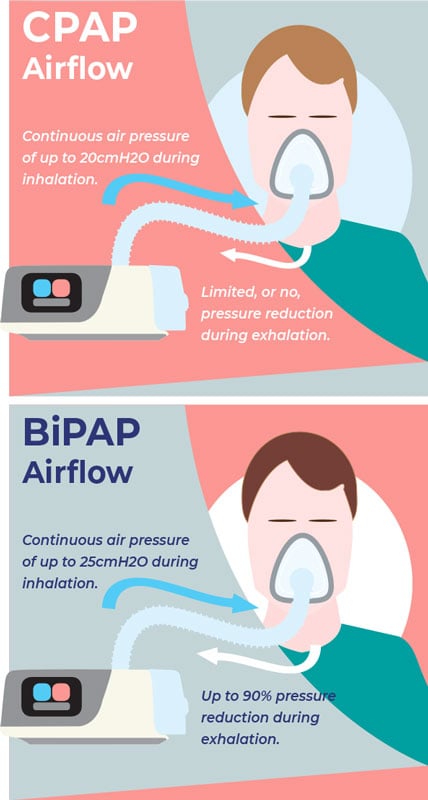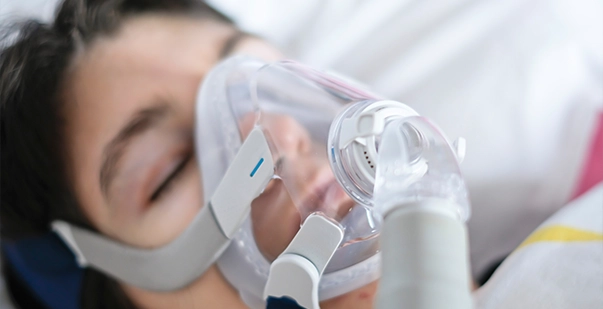BiPAP Rental Solutions for Short-Term Medical Requirements
BiPAP Rental Solutions for Short-Term Medical Requirements
Blog Article
Bipap vs. CPAP: Which Is the most effective for Your Sleep Problem?
When browsing the intricacies of sleep problems, the choice in between BiPAP and CPAP treatment is a critical factor to consider. While CPAP gives a stable air flow appropriate for obstructive sleep apnea, BiPAP's double pressure settings may boost convenience for those with more complex respiratory problems.
Understanding Rest Disorders
Sleep problems encompass a range of problems that interrupt regular sleep patterns, influencing both the quality and period of rest. These conditions can materialize in numerous forms, including sleep problems, rest apnea, narcolepsy, agitated leg syndrome, and parasomnias. Each problem offers distinct challenges, commonly resulting in substantial daytime fatigue, cognitive problems, and emotional disturbances.
Sleep problems is defined by difficulty falling or staying asleep, while sleep apnea entails repeated disruptions in breathing throughout sleep, often causing fragmented rest. Narcolepsy, on the other hand, is marked by excessive daytime sleepiness and sudden sleep strikes. Uneasy leg disorder creates awkward feelings in the legs, triggering an uncontrollable impulse to relocate them, which can likewise impede the capacity to drop off to sleep.
The impact of sleep conditions expands beyond specific wellness, affecting overall efficiency, partnerships, and top quality of life. Comprehending the particular nature of each problem is crucial for reliable diagnosis and treatment. As rest health becomes progressively identified as a crucial element of overall health, resolving these disorders is vital for improving both rest top quality and everyday performance.
How CPAP Works
Continual Positive Air Passage Stress (CPAP) therapy is regularly employed as a primary treatment for obstructive rest apnea (OSA) The mechanism of CPAP entails using a device that supplies a steady stream of air through a mask worn during rest. This air flow maintains favorable stress in the airway, stopping the collapse or obstruction of the throat that can occur throughout rest.
When a patient takes in, the CPAP maker gives a continual circulation of air, guaranteeing that the airway stays open - BiPAP Rental. This not just minimizes the symptoms of OSA, such as snoring and disrupted rest patterns, however additionally decreases the involved health and wellness risks, including cardio complications and daytime fatigue
The pressure settings on a CPAP machine can be personalized to meet specific client needs, commonly established via a sleep research study. In general, CPAP therapy has actually been shown to considerably boost the high quality of sleep and overall health and wellness for people experiencing from obstructive rest apnea.
Just How BiPAP Functions
BiPAP, or Bilevel Positive Respiratory Tract Stress, is a specialized form of non-invasive air flow that is specifically beneficial for people with conditions such as intricate sleep apnea or respiratory problems. Unlike CPAP, which delivers a continual stream of air at a single stress, BiPAP provides 2 unique pressure setups: a higher inspiratory stress for inhalation and a lower expiratory pressure for exhalation. This dual-pressure approach permits easier breathing, reducing the effort needed during exhalation.
The tool runs with a mask fitted over the nose or mouth, connected to a machine that generates atmospheric pressure. When the patient inhales, the equipment provides the higher pressure to help with air flow, guaranteeing that the air passage continues to be open. Upon exhalation, the equipment instantly lowers the stress, making it a lot more comfortable for the client to breathe out.

Secret Distinctions In Between BiPAP and CPAP

On the other hand, BiPAP (Bilevel Positive Airway Pressure) provides 2 various pressure setups: one for inhalation and a reduced one for exhalation. This twin pressure system enables for more comfortable breathing, specifically for patients that fight with exhaling against a constant pressure. BiPAP is typically suggested for individuals with intricate rest apnea, persistent obstructive pulmonary illness (COPD), or those who require added support throughout rest.
Moreover, the intricacy of BiPAP gadgets usually results in a greater cost and calls for extra careful titration than CPAP. BiPAP Rental. Recognizing these essential differences can assist in acknowledging which tool might be a lot more ideal for specific rest disorders, establishing the groundwork for informed therapy decisions
Selecting the Right Therapy
The decision in between you can try these out BiPAP and CPAP treatment primarily pivots on the certain attributes of the sleep condition, the individual's total health, and their comfort with the tool. CPAP, which supplies a continual stream of air, is generally suggested for obstructive rest apnea (OSA)
Alternatively, BiPAP offers 2 levels of pressure: one for breathing and a reduced one for exhalation. This double pressure system is valuable for individuals with complex sleep apnea or those who experience difficulty breathing out versus a continual pressure. Furthermore, BiPAP is commonly advised for individuals with breathing conditions, such as chronic obstructive pulmonary disease (COPD), where varying stress settings can improve convenience and conformity.
Ultimately, a thorough analysis by a rest specialist, consisting of a sleep research, can aid establish which treatment aligns best with the patient's needs. Elements such as comfort, simplicity of usage, and details medical conditions must likewise be taken right into factor to consider to Look At This enhance treatment results.
Conclusion
In summary, both BiPAP and CPAP serve unique objectives in the administration of sleep disorders. CPAP is effective for obstructive rest apnea with consistent airflow, while BiPAP supplies double pressure settings that improve comfort for those with complicated sleep apnea or breathing concerns. The selection between these treatments need to be directed by specific requirements and problems, necessitating an extensive assessment by a rest professional to guarantee optimum therapy outcomes and enhanced high quality of rest.

On the whole, CPAP treatment has been shown to substantially boost the quality of rest and general health for individuals enduring from obstructive sleep apnea.
BiPAP is commonly advised for individuals with complicated sleep apnea, chronic obstructive lung condition (COPD), or those who call for extra assistance throughout sleep.
CPAP is effective for obstructive rest apnea via click now regular air movement, while BiPAP supplies double pressure setups that improve convenience for those with complicated rest apnea or breathing concerns.
Report this page